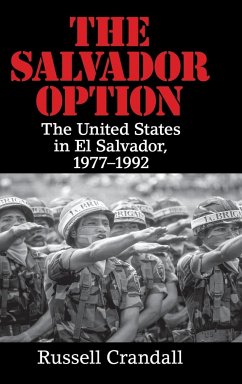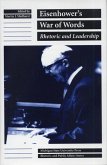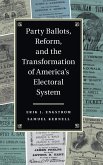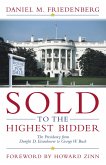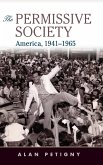Russell Crandall
The Salvador Option
Russell Crandall
The Salvador Option
- Gebundenes Buch
- Merkliste
- Auf die Merkliste
- Bewerten Bewerten
- Teilen
- Produkt teilen
- Produkterinnerung
- Produkterinnerung
This book offers a thorough and fair-minded interpretation of the role of the United States in El Salvador's civil war.
Andere Kunden interessierten sich auch für
![Eisenhower's War of Words: Rhetoric and Leadership Eisenhower's War of Words: Rhetoric and Leadership]() Eisenhower's War of Words: Rhetoric and Leadership38,99 €
Eisenhower's War of Words: Rhetoric and Leadership38,99 €![Party Ballots, Reform, and the Transformation of America's Electoral System Party Ballots, Reform, and the Transformation of America's Electoral System]() Erik J. EngstromParty Ballots, Reform, and the Transformation of America's Electoral System104,99 €
Erik J. EngstromParty Ballots, Reform, and the Transformation of America's Electoral System104,99 €![The Louisiana Purchase and American Expansion, 1803-1898 The Louisiana Purchase and American Expansion, 1803-1898]() The Louisiana Purchase and American Expansion, 1803-1898163,99 €
The Louisiana Purchase and American Expansion, 1803-1898163,99 €![Sold to the Highest Bidder Sold to the Highest Bidder]() Daniel M FriedenbergSold to the Highest Bidder28,99 €
Daniel M FriedenbergSold to the Highest Bidder28,99 €![The Permissive Society The Permissive Society]() Alan PetignyThe Permissive Society85,99 €
Alan PetignyThe Permissive Society85,99 €![Kennedy and the Promise of the Sixties Kennedy and the Promise of the Sixties]() William J. RorabaughKennedy and the Promise of the Sixties69,99 €
William J. RorabaughKennedy and the Promise of the Sixties69,99 €![The Ambiguous Legacy The Ambiguous Legacy]() The Ambiguous Legacy97,99 €
The Ambiguous Legacy97,99 €-
-
-
This book offers a thorough and fair-minded interpretation of the role of the United States in El Salvador's civil war.
Hinweis: Dieser Artikel kann nur an eine deutsche Lieferadresse ausgeliefert werden.
Hinweis: Dieser Artikel kann nur an eine deutsche Lieferadresse ausgeliefert werden.
Produktdetails
- Produktdetails
- Verlag: Cambridge University Press
- Seitenzahl: 720
- Erscheinungstermin: 16. März 2017
- Englisch
- Abmessung: 235mm x 157mm x 46mm
- Gewicht: 1301g
- ISBN-13: 9781107134591
- ISBN-10: 1107134595
- Artikelnr.: 43855822
- Herstellerkennzeichnung
- Libri GmbH
- Europaallee 1
- 36244 Bad Hersfeld
- gpsr@libri.de
- Verlag: Cambridge University Press
- Seitenzahl: 720
- Erscheinungstermin: 16. März 2017
- Englisch
- Abmessung: 235mm x 157mm x 46mm
- Gewicht: 1301g
- ISBN-13: 9781107134591
- ISBN-10: 1107134595
- Artikelnr.: 43855822
- Herstellerkennzeichnung
- Libri GmbH
- Europaallee 1
- 36244 Bad Hersfeld
- gpsr@libri.de
Russell Crandall is a Professor of American foreign policy at Davidson College. His previous books include America's Dirty Wars: Irregular Warfare from 1776 to the War on Terror (2014), The United States and Latin America after the Cold War (2008), Gunboat Democracy: US Interventions in the Dominican Republic, Grenada, and Panama, and Driven by Drugs: US Policy toward Colombia (2006). Interwoven with his academic career, Crandall has held foreign policy appointments within several sectors of the US government, including the Joint Chiefs of Staff, Office of the Secretary of Defense at the Pentagon, and the National Security Council at the White House. He is also a writer at American Interest magazine, a member of the editorial board at America's Quarterly magazine, and a contributing editor and book reviewer at the journal Survival: Global Policy and Strategy.
1. Introduction
Part I. El Salvador in the Cold War: 2. Farabundo Martí, la matanza, and a stolen election
3. The United States in Latin America
4. American military mission in El Salvador
5. A divided nation: military traditions, democratic third way, and liberation theology
6. Guerrillas are born
Part II. Jimmy Carter: 7. Revolution and counterinsurgency in Guatemala
8. Mass organizations
9. Carter arrives
10. Carter and the Sandinista Revolution in Nicaragua, 1979
11. An October coup
12. Carter engages Salvador
13. Archbishop Romero
14. Land
15. The American churchwomen
16. Arming the rebels
17. Guerrilla final offensive, January 1981
18. Death squads
Part III. Ronald Reagan: 19. Reagan arrives
20. Reagan and Salvador
21. El Mozote
22. Another Vietnam
23. Solidarity
24. Troop cap and certifying human rights
25. Reagan gambles on elections, 1982
26. The Shultz doctrine
27. Human rights
28. Henry Kissinger
29. Contras
30. 'Elections yes, dialogue no', 1984 presidential election
31. La Palma
32. Esquipulas
33. Counterinsurgency I
34. Counterinsurgency II
35. Zona rosa
36. Air war
37. José Napoleón Duarte
38. Iran-Contra
Part IV. George H. W. Bush: 39. Elusive justice
40. Pessimism
41. Bush arrives
42. Bush, Cristiani, and the 1989 vote
43. Guerrilla 'second' final offensive, 1989
44. Jesuit killings
45. SAMs
46. United Nations and peace
47. Demobilization
Part V. Post-war: 48. Post-war Salvador
49. Concluding thoughts
Bibliography.
Part I. El Salvador in the Cold War: 2. Farabundo Martí, la matanza, and a stolen election
3. The United States in Latin America
4. American military mission in El Salvador
5. A divided nation: military traditions, democratic third way, and liberation theology
6. Guerrillas are born
Part II. Jimmy Carter: 7. Revolution and counterinsurgency in Guatemala
8. Mass organizations
9. Carter arrives
10. Carter and the Sandinista Revolution in Nicaragua, 1979
11. An October coup
12. Carter engages Salvador
13. Archbishop Romero
14. Land
15. The American churchwomen
16. Arming the rebels
17. Guerrilla final offensive, January 1981
18. Death squads
Part III. Ronald Reagan: 19. Reagan arrives
20. Reagan and Salvador
21. El Mozote
22. Another Vietnam
23. Solidarity
24. Troop cap and certifying human rights
25. Reagan gambles on elections, 1982
26. The Shultz doctrine
27. Human rights
28. Henry Kissinger
29. Contras
30. 'Elections yes, dialogue no', 1984 presidential election
31. La Palma
32. Esquipulas
33. Counterinsurgency I
34. Counterinsurgency II
35. Zona rosa
36. Air war
37. José Napoleón Duarte
38. Iran-Contra
Part IV. George H. W. Bush: 39. Elusive justice
40. Pessimism
41. Bush arrives
42. Bush, Cristiani, and the 1989 vote
43. Guerrilla 'second' final offensive, 1989
44. Jesuit killings
45. SAMs
46. United Nations and peace
47. Demobilization
Part V. Post-war: 48. Post-war Salvador
49. Concluding thoughts
Bibliography.
1. Introduction
Part I. El Salvador in the Cold War: 2. Farabundo Martí, la matanza, and a stolen election
3. The United States in Latin America
4. American military mission in El Salvador
5. A divided nation: military traditions, democratic third way, and liberation theology
6. Guerrillas are born
Part II. Jimmy Carter: 7. Revolution and counterinsurgency in Guatemala
8. Mass organizations
9. Carter arrives
10. Carter and the Sandinista Revolution in Nicaragua, 1979
11. An October coup
12. Carter engages Salvador
13. Archbishop Romero
14. Land
15. The American churchwomen
16. Arming the rebels
17. Guerrilla final offensive, January 1981
18. Death squads
Part III. Ronald Reagan: 19. Reagan arrives
20. Reagan and Salvador
21. El Mozote
22. Another Vietnam
23. Solidarity
24. Troop cap and certifying human rights
25. Reagan gambles on elections, 1982
26. The Shultz doctrine
27. Human rights
28. Henry Kissinger
29. Contras
30. 'Elections yes, dialogue no', 1984 presidential election
31. La Palma
32. Esquipulas
33. Counterinsurgency I
34. Counterinsurgency II
35. Zona rosa
36. Air war
37. José Napoleón Duarte
38. Iran-Contra
Part IV. George H. W. Bush: 39. Elusive justice
40. Pessimism
41. Bush arrives
42. Bush, Cristiani, and the 1989 vote
43. Guerrilla 'second' final offensive, 1989
44. Jesuit killings
45. SAMs
46. United Nations and peace
47. Demobilization
Part V. Post-war: 48. Post-war Salvador
49. Concluding thoughts
Bibliography.
Part I. El Salvador in the Cold War: 2. Farabundo Martí, la matanza, and a stolen election
3. The United States in Latin America
4. American military mission in El Salvador
5. A divided nation: military traditions, democratic third way, and liberation theology
6. Guerrillas are born
Part II. Jimmy Carter: 7. Revolution and counterinsurgency in Guatemala
8. Mass organizations
9. Carter arrives
10. Carter and the Sandinista Revolution in Nicaragua, 1979
11. An October coup
12. Carter engages Salvador
13. Archbishop Romero
14. Land
15. The American churchwomen
16. Arming the rebels
17. Guerrilla final offensive, January 1981
18. Death squads
Part III. Ronald Reagan: 19. Reagan arrives
20. Reagan and Salvador
21. El Mozote
22. Another Vietnam
23. Solidarity
24. Troop cap and certifying human rights
25. Reagan gambles on elections, 1982
26. The Shultz doctrine
27. Human rights
28. Henry Kissinger
29. Contras
30. 'Elections yes, dialogue no', 1984 presidential election
31. La Palma
32. Esquipulas
33. Counterinsurgency I
34. Counterinsurgency II
35. Zona rosa
36. Air war
37. José Napoleón Duarte
38. Iran-Contra
Part IV. George H. W. Bush: 39. Elusive justice
40. Pessimism
41. Bush arrives
42. Bush, Cristiani, and the 1989 vote
43. Guerrilla 'second' final offensive, 1989
44. Jesuit killings
45. SAMs
46. United Nations and peace
47. Demobilization
Part V. Post-war: 48. Post-war Salvador
49. Concluding thoughts
Bibliography.

